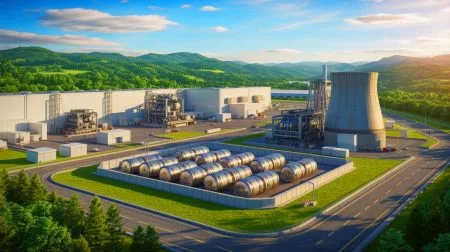| IN A NUTSHELL |
|
As the world grapples with the ever-increasing demand for sustainable energy, the concept of nuclear fusion is making headlines. Often considered a distant dream, fusion energy is now on the brink of becoming a reality, thanks to groundbreaking advancements in technology. This transformative power source, which promises to deliver clean and unlimited energy, is gaining the attention of both scientists and investors alike. Let’s delve into the evolving landscape of fusion energy and explore its potential to revolutionize the global energy market.
The Heart of Fusion: Tokamak Hall and Its Crucial Role
At the center of the nuclear fusion revolution stands the Tokamak Hall, a state-of-the-art facility that could very well be the birthplace of a new energy era. Inside this meticulously maintained, cathedral-like room, scientists are gearing up to host a tokamak—a donut-shaped device essential for achieving fusion. By heating deuterium and tritium to an astonishing 180 million degrees Fahrenheit, the tokamak will facilitate their fusion, releasing immense heat that can be converted into electricity. This process, if successful, represents a giant leap toward harnessing fusion power.
However, the true marvel of this endeavor lies in the adjacent factory floor, where Commonwealth Fusion Systems (CFS) is producing high-temperature superconducting magnets. These magnets are pivotal for maintaining the superheated fuel’s stability during the fusion process. CFS’s innovative approach not only highlights the technological prowess of fusion energy but also underscores its commercial viability. The company’s efforts are supported by significant investments, including from high-profile figures like Marc Benioff, co-chair of TIME.
The All-Out Energy Revolution in the United States
The U.S. energy system is undergoing a transformative shift, driven by rising electricity demand and an urgent need for cleaner power sources. Historically dominated by fossil fuels, the energy landscape is now embracing alternatives like solar and natural gas. Amidst this backdrop, fusion energy emerges as a game-changer, poised to redefine the sector in ways previously deemed impossible.
According to Ernest Moniz, former U.S. energy secretary, the potential for demonstrating fusion conditions within this decade is promising. This shift could pave the way for fusion to become a dominant energy source. Despite past skepticism, policymakers and industry leaders are beginning to recognize fusion’s potential. Recent regulatory changes, such as the Nuclear Regulatory Commission’s decision to streamline fusion reactor regulations, further bolster the prospects of fusion energy’s integration into the grid.
Private Sector’s Role and the Commercialization of Fusion
The journey toward commercial fusion has seen a shift from government-funded research to private sector involvement. Private companies are now at the forefront, bringing a sense of urgency and commercialization to the fusion race. This shift is marked by a significant influx of investment, with over $7 billion raised globally by fusion companies.
Leading this charge is Commonwealth Fusion Systems, which has raised more than $2 billion to revolutionize energy production. By adopting innovative strategies such as hiring from diverse fields and utilizing adaptable products, CFS is accelerating the fusion timeline. Their SPARC facility, set to achieve net energy production by 2027, exemplifies the company’s commitment to rapid progress. With plans to build a commercial power plant in Virginia, CFS aims to deliver fusion power to the grid by the early 2030s, raising questions about the future cost and scalability of fusion energy.
The Global Implications and Future Challenges of Fusion Energy
The potential of fusion energy extends far beyond energy production; it has the capacity to reshape global geopolitics and combat climate change. By providing a virtually limitless source of clean energy, fusion could reduce reliance on fossil fuels and promote global stability. However, technological transitions are rarely straightforward. The emergence of fusion energy could disrupt existing power structures and require significant adaptations in infrastructure and regulation.
Countries like China are closely monitoring fusion developments and investing heavily in state-backed fusion initiatives. If successful, these efforts could alter geopolitical dynamics and shift the balance of power. For now, the challenge lies in preparing for fusion’s commercial emergence while managing current energy demands. As utilities plan for the future, the risk of stranded assets and outdated infrastructure looms large. The fusion revolution is on the horizon, but its full impact remains to be seen.
As the fusion energy landscape evolves, it presents both opportunities and challenges for the global community. The promise of clean, abundant energy is tantalizing, but the journey toward its realization is fraught with complexities. How will nations, industries, and individuals navigate this transformative shift, and what role will fusion energy ultimately play in shaping our future?
Did you like it? 4.7/5 (20)








Wow, “bottling the sun” sounds like something out of a sci-fi movie! 🌞
How soon can we expect fusion energy to become widely available?
Is fusion energy really as clean as they claim?
Thank you for such an enlightening article on fusion energy!
We’re About to Bottle the Sun” – catchy title! But are we really that close?
What are the potential risks associated with nuclear fusion?
The idea of “bottling the sun” is amazing, but how realistic is it?